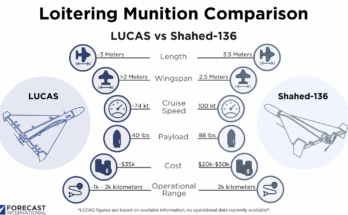
In a soon-to-be-published study on The Market for Light Military Rotorcraft, Forecast International projects that a total of 1,449 such rotorcraft will be produced during the 10-year timeframe from 2023 to 2032. The value of this production is estimated at $17.4 billion as calculated in constant 2023 U.S. dollars. For the purposes of the study, a light military rotorcraft is generally defined as having a maximum gross weight of less than 6,804 kilograms (15,000 pounds), although a couple of exceptions are made to this rule for methodological reasons.
Annual production in the segment has been on the rise since 2021, when the world’s manufacturers produced only 118 light military rotorcraft. Production rebounded in 2022 to 160 rotorcraft, as the market shook off pandemic-induced doldrums. The recovery is continuing in 2023: production is forecast to reach 172 rotorcraft this year. This pace, however, is unlikely to be maintained much longer, and the market is projected to settle back into a more sustainable level of output.

A number of factors are at play here. These include lingering supply chain issues, declining production of certain legacy models, the subsiding of current replacement cycles in certain key markets, and the preference of military operators for medium/heavy rotorcraft types. In 2025, production of only 131 light rotorcraft is forecast. However, increased defense spending, spurred by such geopolitical issues as conflicts in Ukraine and the Middle East or increased tension in the Indo/Pacific region, is expected to result in an uneven rise in production beginning in 2026, with annual output reaching 150 units by 2029.
Starting in the mid- to late 2020s, and continuing into the early 2030s, production will be ramping up for several new acquisition programs, such as the French joint-service Helicoptere Interarmees Leger (HIL) project, the South Korean Army’s Light Armed Helicopter (LAH), the Indian armed forces’ Light Utility Helicopter (LUH), and the U.S. Army’s Future Attack Reconnaissance Aircraft (FARA) program.
Forecast International’s market share projections indicate a close competition among the top manufacturers in the segment. Hindustan Aeronautics Ltd (HAL) of India is forecast to build 352 light military helicopters for a 24.3 percent share of the market. Aviation Industry Corp of China (AVIC) is projected to build 295 helicopters for a 20.4 percent market share. Airbus Helicopters is projected to produce 238 helicopters for a 16.4 percent market share. Korea Aerospace Industries (KAI) of South Korea is forecast to produce 117 helicopters for a market share of 8.1 percent. Leonardo is forecast to garner a 6.7 percent market share on the production of 97 rotorcraft.
HAL also takes the top spot when the market shares are calculated in monetary terms. It is forecast to produce $3.59 billion worth of light military rotorcraft, a market share of 20.7 percent. AVIC is second with $3.39 billion, a share of 19.5 percent. Airbus Helicopters is third with $2.12 billion, a market share of 12.2 percent. KAI is forecast to generate $1.7 billion worth of production, representing a 9.8 percent share. Boeing is forecast to produce $1.55 billion worth of light military rotorcraft for an 8.9 percent share.
Forecast International’s Rotorcraft Forecast provides complete coverage of the worldwide rotorcraft market, ranging from two-seat pistons such as the Robinson R22 up to giant turbine helicopters such as the Russian Helicopters Mi-26. Also included is coverage of tiltrotor aircraft such as the Leonardo AW609 and Bell/Boeing V-22 Osprey. Both the military and civil markets are covered. Due to the nature of present-day conflict, rotorcraft acquisition continues to be a priority for the world’s militaries. And the civil market, despite some current difficulties, has considerable long-term potential. An annual subscription includes nearly 60 reports, most with a 10-year unit production forecast. Five Market Segment Analyses explore the trends and dynamics impacting the various segments of the rotorcraft market, and discuss longer-term programs such as the U.S. military’s Future Vertical Lift project. For more information click here.
Raymond Jaworowski currently co-authors three of Forecast International's best-selling products: Civil Aircraft Forecast, Military Aircraft Forecast, and Rotorcraft Forecast. As a contributor to Aviation Week & Space Technology's Aerospace Source Book, he has authored Aircraft Outlooks, and provided input for the publication's Aircraft Specifications tables. Raymond has represented Forecast International at numerous conferences and trade shows, often as a featured speaker. He is a member of the American Helicopter Society. Prior to joining Forecast International, he worked at Industry News Service and, earlier, interned at the U.S. State Department's Bureau of Intelligence and Research.




